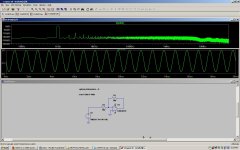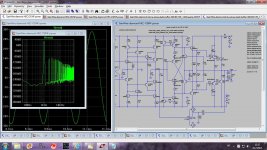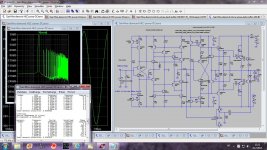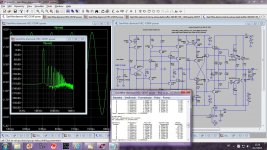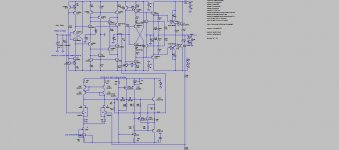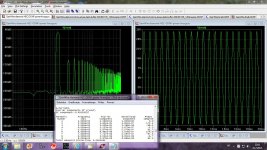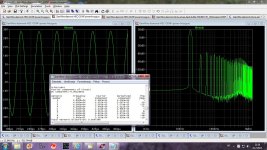With 5 pF it still have small oscilation, with 7 pF is table and distortion at 20kHz drops fro 0.037325% to 0.003628% and that is 20 dB still to little.
Hi dadod. The FB cap around the op amp is for balancing the input and stray capacitance.
This is typical with high GBP op amps, Try an LT1468. They're a bit higher in noise but the distortion is alarming low. If you use very low R for input and FB about the op amp you might get away with no FB cap. The 1468 is actually a 25MHz GBP part at gains below 30. It decompensates itself at gain above 35 to get the 90MHz GBP.
This quite neat what your doing here. Best of luck,
Cheers,
Last edited:
hello,
try an Lt1468.
I see you beat me to the recommendation. But of course.
Cheers,
Thanks Manso, yes I understand important of opamp and I tried to use one from TI (the same as in the papers) but as mcd00uk said could not import yet to the LTspice.
BR Damir
The TI models don't run very well in LTspice. But if you're having trouble send me the TI model and I'll see if I can get it going for you.
A well behaved TI op amp is the OPA1611. Haven't had any trouble from this in the real world.
Cheers,
I see you beat me to the recommendation. But of course.
Cheers,
Thanks davada, here is zip file from TI for LME49710.
Damir
Attachments
With LT1468 THD20k lowered by 26dB(at 8vpp output) and 10pF should be connected between -in and out to tame the opamp, but in this case clipping looks terible. To get better clipping behavior this cap should be increased to 47pF minimum(clipping still not satisfactory) but THD was lowered by 16dB only.
Damir
Damir
With LT1468 THD20k lowered by 26dB(at 8vpp output) and 10pF should be connected between -in and out to tame the opamp, but in this case clipping looks terible. To get better clipping behavior this cap should be increased to 47pF minimum(clipping still not satisfactory) but THD was lowered by 16dB only.
Damir
Hi dadod,
Rather than increasing the fb C. Try putting a resistor at the output of the op amp.
47 - 100 ohm. This isolates external capacitance. The LT1468 is lightning fast settling and an instantaneous short, as capacitors, are cause the op amp to be continuously settling. Also you can try a zobel network at the op amp output. usually 1nF in series with a 100 ohm resistor is enough. You can experiment with the values.
Additionally, you can slow down the differentiation effect with a LP input filter. This should help to clean up the clipping behavior. Or it may be a case of having to add some lead compensation to correct for phase shift since your feed forwarding input signal. Also if the latter is the case you LP filter the feed forward signal to match the phase. I think what you have here is two signals arriving slightly out of phase which canl cause a bit of differentiation.
Can you post a plot of the effect so we can see it.
Cheers,
Last edited:
Hi dadod,
Rather than increasing the fb C. Try putting a resistor at the output of the op amp.
47 - 100 ohm. This isolates external capacitance. The LT1468 is lightning fast settling and an instantaneous short, as capacitors, are cause the op amp to be continuously settling. Also you can try a zobel network at the op amp output. usually 1nF in series with a 100 ohm resistor is enough. You can experiment with the values.
Cheers,
I don't think it will help, there is already 10k (P1) at the output, and zobel does not help either.
I don't think it will help, there is already 10k (P1) at the output, and zobel does not help either.
Off course. I should have looked first.
Cheers,
I will try to compare ODNF type of the power amp with the one with HEC output stage.
ODNF looks very promising but after extensive simulation my opinion is that it has some disadvantage compared with NGNFB with HEC output stage.
At first glance ODNF offers lower distortion, but first it’s tricky to adjust voltage divider at –IN of the opamp for lowest distortion. Attenuation of that divider should be the same as the gain of whole amp, but in practice it differs influenced by used opamp for ODNF feedback. And more it changes with input signal level, at least in the simulation. If we look at distortion harmonics distribution HEC looks much better.
Finally the clipping behavior of HEC is better the the one of ODNF.
Damir
I was wrong about voltage divider exactness (at –IN of the opamp) to achieve lowest distortion. It is not critical at all. I was thinking that is very important that +in and -in of the opamp should be of exactly equal values to get at the output (opamp) distorted residual only. If the divider is not exact still distortion was diminished(very litle influence on THD) but it influences the gain in tine not important amount.
I tried to use LME49710 but got the same stability problem as with LT1468, should investgate more.
BR Damir
Maybe this could be good ODNF (HEC + ODNF)power amp, it needs improvements in high frequences, but I could not make it stable with better opamps. This is at 80W on 8ohm load.
BR Damir
BR Damir
Attachments
This is THD20k first watt.
Hi dadod,
Diamond bridge output stages are very fast and wide band. You may need to do some compensation in the output stage to get the op amp to work with it. The compensation needs to be done in the right place. Trying to do all the compensation at the op amp might prove to be frustrating. Loop analysis on each stage can be helpful. Do you really need all that loop gain to do what you want? Bringing the op amp gain down maybe more stable.
Last edited:
This is a great start on distortion cancellation methods/techniques and ought to draw more attention to new topologies for harmonic distortion reduction. Can we get similar results with less complicated circuit toplogies?
Thx-RNMarsh
Thanks Richard,
This started with NGNFB gain stage with quite low distortion, and it get a bit complicated. It was not intended to be used with ODNF distortion cancelation technic. I think that it could be simplified with similar distortion result.
BR Damir
I think to get this to work right what you need is a differential summing amplifier just to sum the input signal with the output signal and output the difference. The difference should be just the distortion product from the output stage. What you have right now is a huge amount of negative feedback summed with the input signal and output of your voltage amp.
Cheers,
Cheers,
Hi dadod,
Diamond bridge output stages are very fast and wide band. You may need to do some compensation in the output stage to get the op amp to work with it. The compensation needs to be done in the right place. Trying to do all the compensation at the op amp might prove to be frustrating. Loop analysis on each stage can be helpful. Do you really need all that loop gain to do what you want? Bringing the op amp gain down maybe more stable.
Hi David,
I tried first .ac and nothing indicated that there is going to be problem. The otput stage has compensation C1 and C5 is in the gain stage.
But here is interesting part. I used linuxguru opamp from http://www.diyaudio.com/forums/anal...screte-opamp-open-design-294.html#post3568890 and here is result.
Attachments
- Status
- This old topic is closed. If you want to reopen this topic, contact a moderator using the "Report Post" button.
- Home
- Amplifiers
- Solid State
- ODNF or no GNFB power amp
